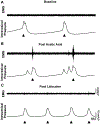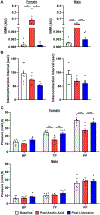Characterization of a method to study urodynamics and bladder nociception in male and female mice
- PMID: 33202486
- PMCID: PMC8474011
- DOI: 10.1111/luts.12365
Characterization of a method to study urodynamics and bladder nociception in male and female mice
Abstract
Objectives: Abdominal electromyogram or visceromotor response (VMR) elicited by bladder distension is a validated as a measure of bladder nociception in mice, however it is not without its limitations. The aim of this study is to address some of these limitations and validate voiding evoked VMR as a measure of bladder nociception mice.
Methods: Using both male and female C57BL/6 mice we assessed the VMR response to cytometry- induced voiding before and after instillation of 0.5% acetic acid into the bladder. We then delivered intravesical lidocaine to confirm the VMR response as nociceptive. VMR and correlative cystometric bladder pressures were analyzed.
Results: We found that the VMR can be evoked by continuous fluid infusion into the bladder of both male and female mice. This response is potentiated after bladder injury and can be attenuated by administration of a local anesthetic, providing strong evidence that this method can be used to evaluate bladder nociception. Further, evaluation of cystometric pressure traces obtained during VMR recording revealed that intercontraction intervals were not altered after bladder injury in either male or female mice. However, we did observe a decrease in peak threshold pressures after bladder injury in female mice, which could be rescued by lidocaine administration.
Conclusions: In conclusion, this technique can measure the VMR and bladder nociception associated with voiding in both female and male mice. Although confounds still exist with the use of anesthesia, further exploration of non-anesthetized voiding-evoked VMR is warranted.
Keywords: bladder pain; mouse cystometry; visceral motor response (VMR).
© 2020 John Wiley & Sons Australia, Ltd.
Figures




References
-
- Hall SA, et al., The relationship of common medical conditions and medication use with symptoms of painful bladder syndrome: results from the Boston area community health survey. J Urol, 2008. 180(2): p. 593–8. - PubMed
MeSH terms
Grants and funding
LinkOut - more resources
Full Text Sources

